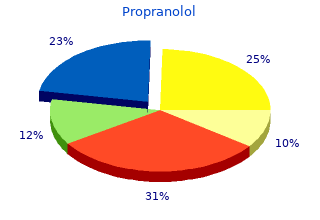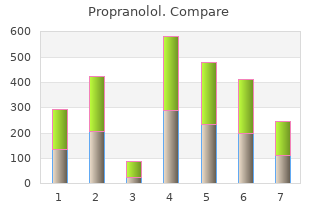

2018, Saginaw Valley State University, Joey's review: "Propranolol 80 mg, 40 mg, 20 mg. Only $0.23 per pill. Buy online Propranolol no RX.".
An underlying neurologic disorder buy propranolol 80mg low price coronary artery x-ray using contrast, as yet undetermined order 40 mg propranolol with amex capillaries disorder, is currently considered as the likely basic pathomechanism. The initial type demonstrates generalized joint contractures involving primarily the limbs; a second type shows limb contractures in association with other areas of affectation of the viscera, or face and skull; and a third group has been differentiated as having congenital contractures associated with central nervous system disturbance. In the initial group of congenital joint contractures primarily involving the limbs, children are symmetrically affected with a combination of flexion and extension contractures in all limbs. There is marked apparent atrophy of muscle tissue (amyoplasia) and a tremendous reduction in active and passive motion of joints. Characteristically there are usually a few degrees of passive motion beyond the voluntarily producible range of motion. Skin creases tend to be absent and “dimpling” may be present at the joint levels. Commonly in the upper extremities, the shoulders are internally rotated, the elbows may either be flexed or Miscellaneous disorders 122 extended, and the forearms are pronated with the wrists usually in flexion and the thumbs flexed into the palm (Figure 6. In the lower extremities the feet are characteristically in equinovarus (clubfoot) with the knees presenting with either flexion or extension contractures and even knee dislocation. The hips may be located and lying in flexion and external rotation, or they may be dislocated (Figure 6. It is important to remember that intelligence is generally normal, and treatment is designed to deal with the very severe contractures and deformities. A distal form of this basic type of involvement has been recognized, primarily involving the hands and feet, with a characteristic posturing as seen in the more extensive type. A much larger group of patients have multiple congenital contractures associated with central nervous system dysfunction and are commonly associated with chromosomal abnormalities. There is a very high attrition rate during the first few years of life – nearing 50 percent. Two types of presentation of this are generally recognized: a neuropathic form and a myopathic form. The myopathic form is not associated with changes in the brain or the anterior horn cells and appears to be a direct affectation of the muscle tissue with replacement thereof with fibrous and fatty tissue. The deformities seen are common to all types of arthrogryposis, and pose perplexing problems in orthopedic management. The severe rigidity of the tissues necessitates extensive surgical releases and bony reconstructive procedures to restore 123 Cerebral palsy alignment, and position the lower extremities for weight bearing. Surgery is most often directed at the lower extremities, the hand, and the management of spinal deformity. Cerebral palsy In spite of the fact that entire texts have been written about this condition, it is appropriate to include a discussion of management, particularly as it pertains to the perspectives of the pediatric orthopedist and the primary care physician. Cerebral palsy is generally defined as a non-progressive, non-transient disorder affecting the brain or spinal cord and occurring during the antenatal or early postnatal period. It is suggested that the lesion affects the developing central nervous system in a one-time fashion. Associated with the noted impairment are the obvious involvement of mentation, speech, hearing, vision, and sensation. The result of the neurologic impairment is a disturbance of movement with skeletal deformation. Cerebral palsy classification by type Affected patients are generally classified as to the type of neurologic involvement, and as to Spasticity (85–90%) the pattern of involvement within the trunk Athetosis and extremities (Pearls 6.


In effect cheap propranolol 40 mg free shipping blood vessels on the liver, each author must be able to present the results proven 40 mg propranolol cardiovascular klabunde, defend the implications, 31 Scientific Writing Decide authorship Agree on authors’ roles and responsibilities Agree on acknowledgements Agree on up to three journals Obtain instructions to authors Collect the “Uniform Requirements” and any other useful checklists Figure 2. These responsibilities protect coauthors and preclude “gift” authors, since no researcher should allow their names to be associated with results that they know very little about. Whatever their positions in the author list, coauthors always have both ethical and professional responsibilities for the content of the paper. Thus, only the people who have participated sufficiently in the research project to take public responsibility for the content should be included. Once the authorship list is finalised, you can work towards an agreement on the role of each coauthor and the work that they will put into the paper. There are no formal guidelines so you will have to negotiate your expectations with those of your coauthors. Although the number of authors on journal articles has tended to increase in recent years, four or five authors is usually optimal. Limiting the number of authors may be particularly important for the career advancement of students who are undertaking a higher degree and who are required to make a very substantial contribution to their papers. Having fewer authors also avoids diluting the responsibility that each author must take for the paper. In practice, more than four authors should be included only if there is a good reason for doing so and some journals set author limits. For example, the journal Thrombosis and Haemostasis sets a limit of eight and Chest sets a limit of seven. The New England Journal of Medicine sets a limit of 12 authors, after which other names must appear in a footnote. A suggested maximum number of authors for each type of publication is shown in Table 2. A study on multiple authorship showed that the mean number of authors on journal articles increased from 2·2 in 1975 to 4·5 in 1995, with a disproportionate growth in the inclusion of professors and departmental chairpersons. Some journals, for example JAMA and the New England Journal of Medicine, now ask authors to certify that they meet the Vancouver criteria when a paper is submitted, and many journals include these criteria in their instructions to authors. Journals such as the BMJ and Lancet also request a statement of each author’s exact contribution to the paper. To avoid authorship problems, research groups need to develop a departmental policy on authorship criteria that is regularly visited, discussed, and updated in a consensus forum. Many 34 Getting started research institutions also develop their own code of ethics for acknowledgements and contributions in publications. Standardised policies that are developed collaboratively and ratified by the heads of research departments within institutions are worth their weight in gold in preventing conflicts and resolving contentious and often emotional authorship and acknowledgement issues. Because authorship is such a serious issue, many journals will not consider a paper for publication without the signatures of all authors. Most journals also require a declaration of competing interests from their authors and contributors. The Lancet in its instructions to authors suggests that authors use the following statement: I declare that I participated in the (here list contributions made to the study such as design, execution or analysis of the paper) by … and colleagues entitled … and that I have seen and approved the final version. It is also a good idea to add “I also declare that I have no conflict of interest in connection with this paper other than any noted in the covering letter to the editor”. If these statements are completed on separate pages and left undated, they can be used if the paper is rejected and then submitted to another journal. There have been cases where pharmaceutical companies have applied undue pressure on researchers to avoid publishing data that suggest that their products are inferior or ineffective. In response to what editors perceive as increasing control by drug companies over how the results of sponsored studies are analysed, many journals now require that authors fully disclose their own roles and those of their sponsors.

CORTICOSTEROIDS Dantrolene is indicated for the treatment of spasticity secondary to spinal cord injury order propranolol 80 mg amex arteries disease. MUSCLE RELAXANTS Because long-term use is controversial purchase propranolol 40mg without prescription cardiovascular disease exercise, diazepam should be used in selected cases only. It decreases excitability of the motor end- controversial and the efficacy studies are less con- plate. TIZANIDINE Because of the minimal literature on the clinical use of NMDA antagonists, it is difficult to provide guide- Tizanidine is a centrally acting α -adrenergic agonist lines. REFERENCES Tizanidine is indicated for the treatment of spasticity secondary to spinal cord injury and multiple sclerosis. Methotrimepraxine: A new phenothiazine derivative with analgesic properties. Chlorprothixene therapy for herpes carisoprodol, chlorphenesin carbamate, chlorzoxa- zoster neuralgia. Chlorprothixene in post-herpetic neuralgia and other severe chronic pain. Validity and sensi- Many of these are available in combination with cer- tivity of ratio scales of sensory and affective verbal pain tain other drugs. Comparison of the analgesic effect of Cyclobenzaprine is structurally similar to the tricyclic morphine, hydroxyzine and their combinations in patients antidepressants. Analgesic/calmative effects of acetaminophen and pheynyltoloxamine in treatment of simple nervous ten- NMDA RECEPTOR ANTAGONISTS sion accompanied by headache. Caffeine as an an influx of calcium, which initiates a cascade of adjuvant analgesic. Section V ACUTE PAIN MANAGEMENT in analgesic requirements between patients and even 17 INTRAVENOUS AND within patients. SUBCUTANEOUS PATIENT- Variability in patient-specific opioid requirements CONTROLLED ANALGESIA during PCA therapy results from differences in phar- macokinetics, pharmacodynamics, pain intensity, Anne M. Savarese, MD psychological makeup, anxiety, and previous painful experiences. CONTRAINDICATIONS Initial choice of opioid is influenced by practitioner familiarity and preference, as well as patient factors History of device tampering with prior PCA use/opi- such as prior drug responses, clinical status, comorbid oid diversion conditions, and expected clinical course. TABLE 17–1 Suggested Intravenous PCA Prescriptions for Opioid-Naïve Adult Patients STOCK LOADING PCA SOLUTION DOSE DOSE LOCKOUT BASAL RATE 1-H LIMIT DRUG (mg/mL) (mg) (mg) (min) (mg/h) (mg) Morphine 1 2–5 0. INTRAVENOUS OPIOID PCA: The dosing interval should reflect the time to peak TIPS FOR SUCCESS effect for the prescribed opioid, so that successive doses are not administered before the patient “feels” PCA technology facilitates on-demand analgesia tai- the effect of the preceding self-administered dose. The success, efficacy, and safety of The lock-out interval protects the patient from repeti- PCA are enhanced by: tive doses (despite demands) over too short a period, Management by a dedicated acute pain service while permitting an adequate interval for successive (APS) doses to be successfully delivered so that an effective Prescribing of PCA, as well as supplemental anal- analgesic plasma concentration is achieved, especially gesics, sedatives, and transition analgesics, during active periods with increased analgesic restricted to one team only, ideally an APS requirements. Establishment of institutional policies, standardiza- tion of opioid formulations, preprinted PCA order sets, and management guidelines to ensure consis- TIME-BASED CUMULATIVE DOSE LIMIT tent clinical practice Staff education about PCA and pain management in This parameter allows the clinician to restrict the general patient’s cumulative opioid consumption to a time- Patient/family education about PCA therapy (see based limit, typically 1 or 4 hours. Table 17–2) 80 V ACUTE PAIN MANAGEMENT TABLE 17–2 PCA Teaching Tips for Patients and Families TABLE 17–3 Opioid-Related Side Effect Management for Adult Patients on PCA Therapy 1. Demonstrate how to use the pump to give pain medication, and have the patient return the demonstration. Instruct the patient in the use of an appropriate assessment tool Nausea/vomiting Reduce the dose of opioid (pain scale). Inform the patient that the goal of PCA therapy is a resting pain or score (PS) of 0 to 3, and a dynamic PS of ≤ 5 on a 0–10 pain scale, where 0 = no pain and 10 = the worst pain possible. Instruct the patient and family members that only the patient is to activate the PCA demand button. Explain that the lock-out interval is set so that the patient cannot Metoclopramide 10–20 mg IV q6h receive additional medication until the last dose has had some or effect, regardless of how often the demand button is pressed.
SHARE THE DANA LANDSCAPING PAGE